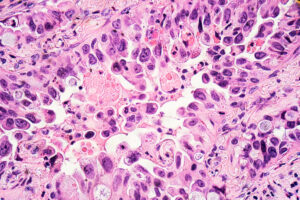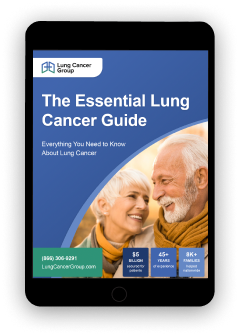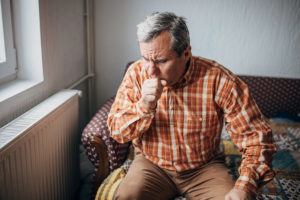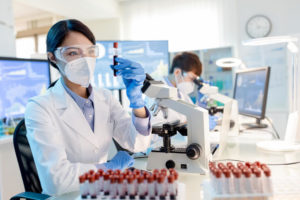Adenocarcinomas in the Lung
Adenocarcinoma is a type of cancer that develops in the glands lining your lungs and other organs. You could develop adenocarcinoma in the lung after smoking cigarettes, being exposed to asbestos, or coming into contact with other toxic substances. Thankfully, there are medical treatments available for lung adenocarcinoma to help you live longer.
What Is Lung Adenocarcinoma?

Adenocarcinoma is cancer that first forms in the glands lining major organs. Adenocarcinoma can form in many body parts, most notably the lungs. Smoking, asbestos, and other harmful substances can all cause adenocarcinomas of the lung.
Adenocarcinoma of the lung is actually a form of non-small cell lung cancer (NSCLC), according to the American Cancer Society (ACS). It’s also the most common type of NSCLC, accounting for 40% of all cases diagnosed, as noted by the American Society of Clinical Oncology (ASCO).
Lung adenocarcinoma kills more people than any other cancer does per year, according to the U.S. National Library of Medicine. However, it’s still possible to get treatment and become a long-term survivor.
Lung Cancer Group can help you and your loved ones get financial aid after a diagnosis of lung adenocarcinoma or any other subtype of lung cancer. This financial compensation can be used to help afford medical bills and other expenses.
Learn about your options now with a Free Lung Cancer Guide.

- Understand risk factors
- Find top treatments
- Pursue compensation



What Causes Lung Adenocarcinoma Tumors?
Several factors can lead to the development of lung adenocarcinoid tumors. The U.S. National Library of Medicine notes that smoking is the biggest cause of lung adenocarcinoma.
Tobacco contains over 7,000 harmful chemicals, according to the Centers for Disease Control and Prevention (CDC). Those that smoke are 15-30 times more likely to develop lung cancer than nonsmokers.
- Asbestos: This is a fiber-like material that was once used in thousands of products. Tiny asbestos fibers can get stuck in the lungs and cause lung adenocarcinoma and other types of lung cancer 10-50 years later.
- Secondhand smoke: Exposure to secondhand smoke can lead to adenocarcinomas of the lung, even in those who never smoked.
- Toxin exposure: Besides asbestos, City of Hope National Medical Center notes that toxins like diesel, radon, nickel, tar, and soot can all lead to adenocarcinomas of the lung.
Who Is at Risk for Adenocarcinomas of the Lung?
A risk factor is something that increases the likelihood of developing a condition. Anyone who smoked or was exposed to asbestos, secondhand smoke, or other cancer-causing substances is at risk of lung adenocarcinoma.
There are also a couple of risk factors that are out of a person’s control.
- Are a woman: City of Hope notes that more women develop lung adenocarcinomas than men.
- Had radiation therapy: Certain types of radiation therapy can lead to adenocarcinoma.
- Have family members that developed lung cancer: Some families are at a higher risk of adenocarcinomas of the lung due to genetics and a history of smoking. Johns Hopkins Medicine notes your risk of getting lung cancer is doubled if a family member had it.
- Were exposed to air pollution: Severe air pollution may increase your chances of developing adenocarcinomas of the lung.
The best way to lower your risk of developing adenocarcinomas of the lung and other lung cancers is to quit smoking. It’s also a good idea to make sure you aren’t being exposed to toxic substances like asbestos at home or at your job.
Symptoms of Lung Adenocarcinoma
Patients may or may not experience noticeable symptoms of lung adenocarcinoma when the cancer is first forming.
When symptoms do appear, they include:
- Chest pain
- Coughing that doesn’t go away or gets worse
- Coughing up blood or bloody mucus
- Feeling tired all the time (fatigue)
- Loss of appetite
- Pleural effusion (fluid buildup in lung lining)
- Problems breathing or swallowing
- Raspy voice
- Shortness of breath
- Swelling of the face or veins in neck
- Weight loss with no known cause
- Wheezing


Finally, patients can sometimes experience other conditions as adenocarcinoma of the lung spreads and the body’s immune system responds to it.
These include Eaton-Lambert syndrome (where the body attacks its own nerves), Horner’s syndrome (which causes droopy eyelids, changes in pupil size, and lack of sweating on one side of the face), and hypercalcemia (where there’s too much calcium in the body).
Do you have symptoms of lung adenocarcinoma? Find out your eligibility for financial compensation. Call (877) 446-5767 now.
Diagnosing Adenocarcinomas of the Lung
To determine if you have lung adenocarcinoma, City of Hope notes that doctors will first perform a physical exam and ask about your current symptoms, if any.
Tell your doctor if you smoked or were exposed to asbestos, secondhand smoke, or other cancer-causing substances in your first appointments. This can help doctors rule out less serious conditions.
Your doctors will then likely order imaging scans and other tests to check for signs of cancer within your lungs.
Common diagnostic tests for lung adenocarcinoma may include:
- Blood tests: ASCO notes that a blood test may reveal fragments of DNA from dead lung cancer cells in your body, which can help narrow down if you have lung adenocarcinoma.
- Computed tomography (CT) scans: A CT scan is a procedure that takes three-dimensional images of the tissues inside your body.
- Magnetic resonance imaging (MRI) scans: This imaging test uses magnets, a computer, and radio waves to take pictures of your tissues and organs.
If doctors believe you might have lung adenocarcinoma after this stage, they’ll order a biopsy. A biopsy is a small tissue or fluid sample taken from the body.


Patients that don’t have any symptoms of lung adenocarcinoma are sometimes diagnosed by chance, according to City of Hope National Medical Center. For example, the patient may be getting an X-ray for another condition and doctors will notice a possibly cancerous spot or growth in the lung.
Adenocarcinoma Misdiagnosis
Health care providers may misdiagnose adenocarcinoma at first, as the cancer shares symptoms with many other conditions.
Adenocarcinoma of the lung can be mistaken for:
- Asthma
- Bronchitis
- Pleurisy
- Pneumonia
- Tuberculosis
Misdiagnosis of lung adenocarcinoma can delay proper diagnosis and treatment. If you believe your adenocarcinoma has been misdiagnosed, get a second opinion from another oncology (cancer) expert.
Stages of Lung Adenocarcinoma
City of Hope notes that there are five main stages of lung adenocarcinoma, just like all other types of NSCLC. Doctors can determine lung adenocarcinoma stage at the time of diagnosis.
Which stage of lung cancer a patient is diagnosed with can greatly impact their overall prognosis and available treatment options.
Lung adenocarcinoma stages include:
- Stage 0: Cancer cells are found in the outer part of a lung
- Stage I: A tumor is found in the lung
- Stage II: The cancer has spread deeper into the lungs and/or to local lymph nodes
- Stage III: The cancer has reached further into the lungs, lymph nodes, and/or nearby body parts
- Stage IV: Widespread metastasis (spread) has occurred, and the cancer is found in one or more organs that are far away from the lung
Patients typically don’t start experiencing symptoms until stages III or IV, by which point the cancer has started to spread. However, doctors may recommend additional scans (such as a brain MRI) to rule out metastasis if a patient is diagnosed in stage II or higher.
Patients with any stage of lung adenocarcinoma may qualify for financial compensation. Learn more in our Free Lung Cancer Guide.



- Understand risk factors
- Find top treatments
- Pursue compensation



Lung Adenocarcinoma Prognosis
The prognosis or outcome of adenocarcinoma varies depending on the size, location, and type of the tumor. Adenocarcinoma tumors that have metastasized (spread) to other parts of the body are more likely to have poor prognoses.
Prognosis is measured using survival rates and life expectancies. View lung adenocarcinoma survival statistics for each below.
Life Expectancy for Lung Adenocarcinoma
Life expectancy is how long a patient is projected to live following a lung adenocarcinoma cancer diagnosis. A 2020 study from the Turkish Journal of Medical Sciences found that the average life expectancy for lung adenocarcinoma patients ranged from 11-14.2 months.
Lung Adenocarcinoma Survival Rates
Survival rates can show you what percentage of people with lung adenocarcinoma are still alive after they were diagnosed. They are typically measured in years.
- The overall 5-year survival rate for lung adenocarcinoma is 12%.
- Those with stage I adenocarcinoma have a 5-year survival rate ranging from 70%-85%.
- Patients in stage IV have a 5-year survival rate of less than 5%.
- Patients in between stages I and IV have a 5-year survival rate of less than 30%.
While these survival statistics can seem scary, it’s important to know that medical treatment may help you live longer.
Treatment Options for Adenocarcinomas of the Lung
There are many ways to treat lung cancers like adenocarcinoma, depending on what stage of the cancer you have, your overall health, and other factors.
Surgery
Surgery is often a very effective treatment for lung adenocarcinoma and other cancers as it allows doctors to physically remove the tumors from the body, along with nearby surrounding tissue.
The U.S. National Library of Medicine notes that surgery is often available for patients with stage I to stage III lung adenocarcinoma. Part of the lung or the entire lung where the cancer tumor has grown into will be removed.
Chemotherapy


Chemotherapy is often used to help lung adenocarcinoma patients who have undergone surgery to reduce the chances of recurrence (in which the cancer comes back).
Patients may suffer from side effects like nausea after chemotherapy as it kills both healthy cells and cancer ones.
Radiation Therapy
Radiation therapy shrinks and kills cancerous tumors by damaging cancer cells’ DNA. Once the cells’ DNA has been damaged beyond repair, they will stop dividing and die.
As with chemotherapy, doctors may use radiation therapy to help prevent a recurrence of lung adenocarcinoma. And, again like chemotherapy, radiation can cause side effects like fatigue because healthy cells will also be killed.
Targeted Therapy
Targeted therapy uses drugs to destroy cancer cells. However, compared to radiation and chemotherapy, fewer healthy cells are destroyed in the process.
The U.S. National Library of Medicine notes that targeted therapy can be used to treat metastatic lung adenocarcinoma, and that this treatment may help patients live slightly longer. However, this treatment can be prohibitively expensive, costing $20,000 or more per month.
Thankfully, you may qualify for financial aid for lung adenocarcinoma treatments. Learn more by calling (877) 446-5767 right now.
Immunotherapy
Immunotherapy is a kind of lung cancer treatment that stimulates your immune system to fight cancer.
Immunotherapies used to treat adenocarcinoma include:
- Cancer vaccines: The vaccine allows the immune system to destroy lung cancer cells more easily.
- Immune checkpoint inhibitors: These drugs allow immune cells to react more strongly to lung adenocarcinoma cells.
- T-cell transfer therapy: This boosts the natural ability of your T-cells to fight adenocarcinoma.
Alternative Treatments
Alternative cancer treatments may not directly treat or cure your lung adenocarcinoma. However, they can help you cope with symptoms caused by the cancer and ease the side effects of medical treatments, such as pain, fatigue, anxiety, insomnia, and stress.
Alternative treatments for adenocarcinoma include:
- Acupuncture
- Meditation
- Yoga
Make sure to speak with your lung cancer care team before starting any alternative treatments for lung adenocarcinoma.
Clinical Trials
Clinical trials are cancer research studies testing new drugs, surgeries, and other forms of treatment.
You can find a clinical trial for lung adenocarcinoma by asking your health care provider or signing up for a matching service.
Once you have found a suitable trial, tell your doctor. They may want to talk to the research team to ensure that the study is safe for you.
Help for Lung Adenocarcinoma Patients
A lung adenocarcinoma diagnosis can be incredibly stressful. Treatments can also be expensive.
Fortunately, if you or a loved one has been diagnosed with lung adenocarcinoma, you may qualify for financial aid. The compensation you might receive can help you cover medical treatments, basic living expenses, and much more.
Find out your eligibility for lung adenocarcinoma compensation: Get a free case review right now.
Common Questions About Lung Adenocarcinoma
What’s the difference between mesothelioma vs. adenocarcinoma?
Lung adenocarcinoma develops in the glandular cells of the lungs and is very common, accounting for 4 in 10 NSCLC diagnoses.
Mesothelioma, on the other hand, is a rare type of cancer that affects the lining of the lungs, abdomen, heart, or testicles. Only 3,000 cases are diagnosed per year.
That said, both lung adenocarcinoma and mesothelioma can be caused by asbestos exposure, and financial compensation might be available to patients with either cancer. Learn more by calling (877) 446-5767.
Can lung adenocarcinoma spread to the rest of my body?
Yes, invasive lung adenocarcinoma can spread to other parts of your body. Cancer cells can break away from a tumor and migrate throughout your body through the lymph or blood system.
This is why it’s important to see a cancer doctor as soon as possible if you might have lung adenocarcinoma. Getting diagnosed before the cancer spreads will mean you have a better chance at long-term survival.
Is lung adenocarcinoma curable?
It’s typically hard to cure lung adenocarcinoma, as the cancer is prone to recurrences. That said, the ACS notes that treatments like surgery can be used to possibly cure early-stage patients.
Late-stage patients are very unlikely to be fully cured of lung adenocarcinomas or other types of NSCLC, but treatments can still help patients live for long spans of time.
Is adenocarcinoma of the lung always fatal?
No, adenocarcinoma is not always fatal. It can be successfully treated in many cases, especially if the tumor has not metastasized.
Get a Free Lung Cancer Guide to learn about treatments that could help you or a loved one live longer.

